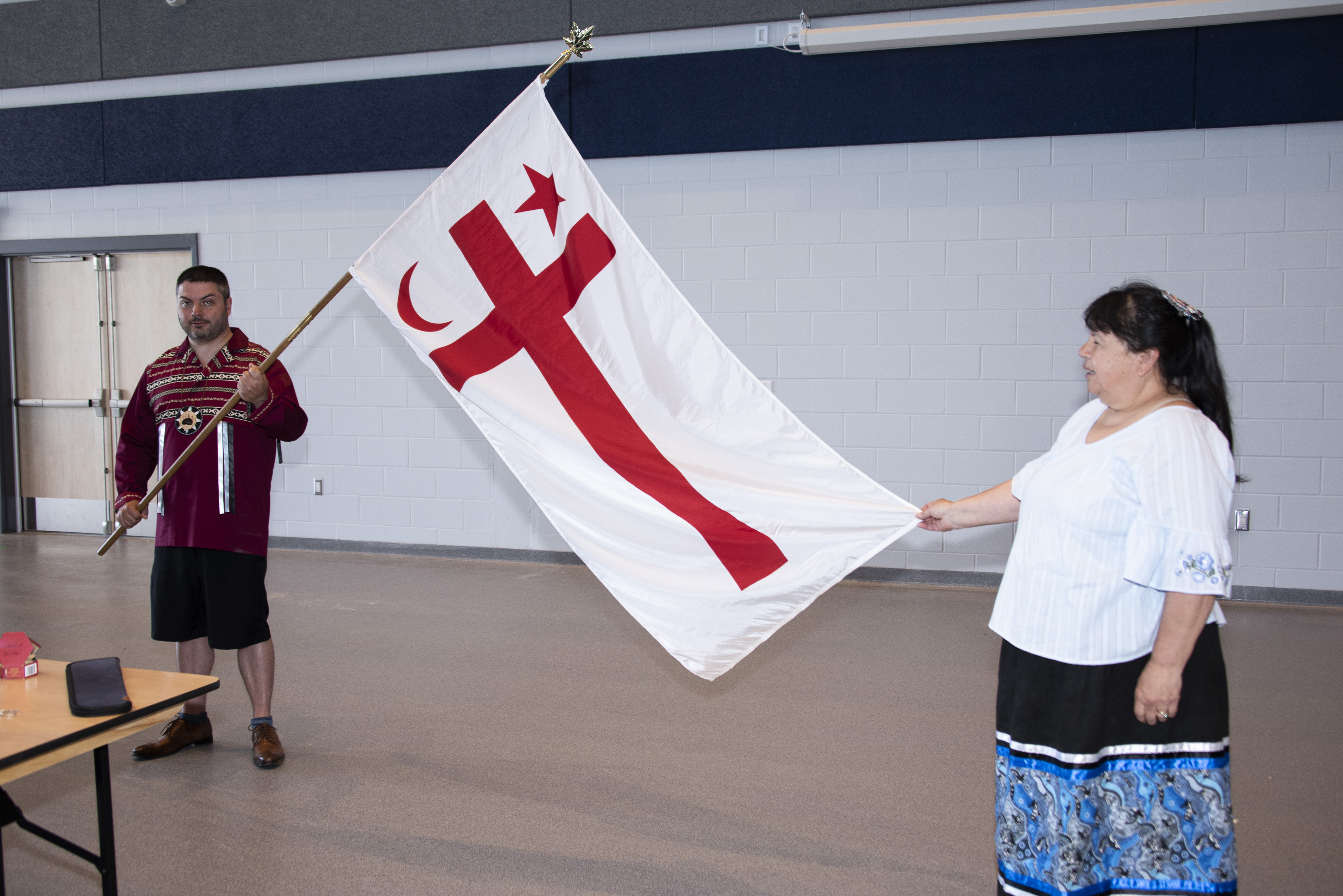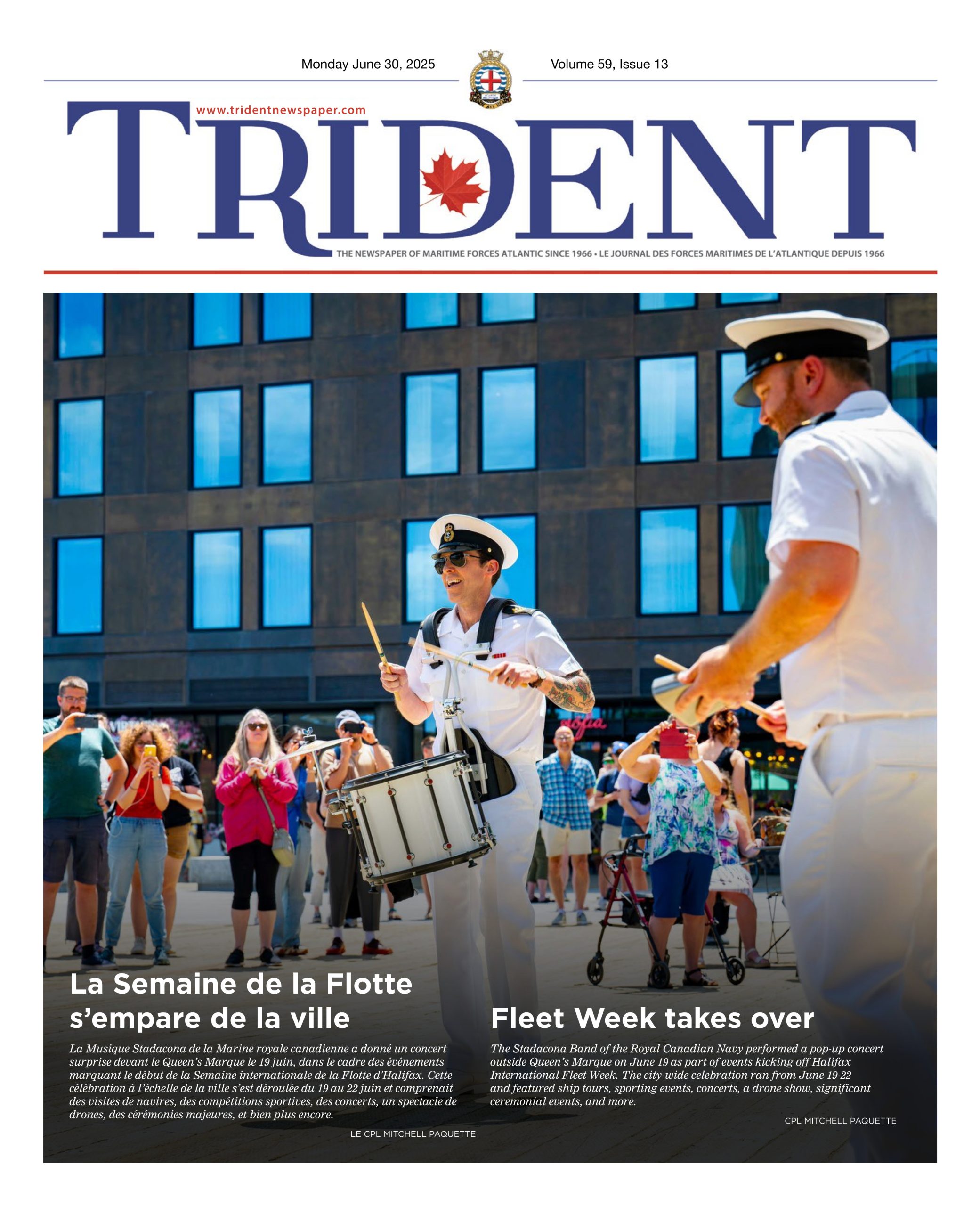
CPL IAN THOMPSON, FORMATION IMAGING SERVICES
Flag Installation Marks Continued Effort Toward Reconciliation at CFB Halifax
Elizabeth Sharpe,
CFB Halifax PA Intern
A Mi’kmaq Grand Council flag has found its home inside the newly built Common Support Training Facility (CSTF) at Canadian Forces Base (CFB) Halifax. The flag was installed during an intimate ceremony on June 19, 2020 – just two days before Canadians recognized National Indigenous Peoples Day, a commemoration marked annually on June 21. The CSTF’s drill shed displays the Canadian flag, followed by each of the provincial and territorial flags in the order that they joined Confederation, and now the Mi’kmaq flag.
This flag installation was both significant and symbolic, as CFB Halifax is located on Mi’kma’ki, the ancestral and unceded territory of the Mi’kmaq people. This territory is covered by the “Treaties of Peace and Friendship” which Mi’kmaq and Wolastoqiyik (Maliseet) People first signed with the British Crown in 1725. The treaties did not deal with surrender of lands and resources but in fact recognized Mi’kmaq and Wolastoqiyik (Maliseet) title and established the rules for what was to be an ongoing relationship between nations.
Lieutenant Commander (LCdr) Todd Harnish, Naval Fleet School (Atlantic) (NFS(A)) Seamanship and Leadership Division Commander, was grateful to be present for the flag installation ceremony, as his team is responsible for the seamanship training that takes place within the walls of the CSTF.
“With many personnel travelling through this new facility for their seamanship training, having the Mi’kmaq flag on display will be a reminder to our sailors of the ongoing efforts of the Navy to maintain a strong relationship with Indigenous Peoples in the future,” explains LCdr Harnish. “Our hope is that [the presence of the flag] and other areas of the building dedicated to Canada’s Indigenous Peoples, their artifacts and their stories, will educate users of the facility and will welcome First Nations, Inuit and Metis People into the military and this facility,” he adds.
Two respected Indigenous community leaders, retired Chief Petty Officer 2nd Class (CPO2) Debbie Eisan and Raymond Sewell, led the flag installation ceremony, accompanied by local Canadian Armed Forces (CAF) leadership. Sewell, an l’nu from the Mi’kmaq community of Pabineau First Nation in New Brunswick, works at Saint Mary’s University in Halifax as Indigenous Student Advisor and a religious studies lecturer. CPO2 (ret’d) Eisan is an Indigenous elder and Royal Canadian Navy veteran, originally from Sault Ste. Marie in Northern Ontario; she is Ojibway from the Batchewana First Nation. It is important to note that Mi’kma’ki is not her territory, but she is extremely grateful to have been accepted by the Mi’kmaw community in Halifax when she was posted here during her military service. She is now an elder of the Indigenous community in Halifax, as well as the Community Planner at the Mi’kmaw Native Friendship Centre.
Since her retirement from the military, CPO2 (ret’d) Eisan has maintained her connection to the local CAF community through various workshops and events at CFB Halifax – such as this flag installation – in which she participates as an Indigenous educator, representative and healer. Through these engagements, she has observed a notable improvement in Indigenous relations since her time as an active CAF member.
“They are listening and understanding, and they are understanding what working together means,” she explains. “When I joined the military, you wouldn’t expect to see a Smudging Ceremony at a Change of Command Ceremony. Now, I have been invited to conduct a Smudging at Changes of Command and other different events, it’s truly remarkable.”
Commodore (Cmdre) Matt Bowen, Champion of the Atlantic Defence Aboriginal Advisory Group (ADAAG), was on-hand for the flag installation ceremony. The ADAAG is dedicated to providing advice and insight to senior leadership on issues affecting the recruitment, retention, development and promotion of Indigenous Peoples within the CAF and the Department of National Defence (DND). Cmdre Bowen believes that the Mi’kmaq flag being permanently on display at the CSTF is significant in remembering the historical relationship between the CAF community and Indigenous Peoples in Canada.
“It’s important that the Defence Community recognize the contributions that Indigenous Peoples have made throughout the history of our organization, as that relationship goes back to the founding of our armed forces in service to Canada and beyond,” he explains.
Before the COVID-19 pandemic altered the working arrangements of many local Defence Team members, the ADAAG was working to promote CAF relationships with the local Indigenous community in the lead-up to the (now postponed) 2020 North American Indigenous Games (NAIG), which were supposed to take place this summer in Kjipuktuk (Halifax), Millbrook First Nation and Aldershot, Nova Scotia. Additionally, the group regularly supports recruiting efforts and engagement with local Indigenous communities by having its members participate in forums, meetings and discussion when opportunities permit. Going forward, Cmdre Bowen is planning to focus the ADAAG efforts on addressing systemic racism, especially now in a time where the world is putting a magnifying glass on anti-Black and anti-Indigenous racism.
“The biggest challenge we face is maintaining focus and attention on the cultural shifts that are necessary to address systemic racism,” he explains. “Humans can have short attention spans, and there is always a new crisis or tragedy to distract attention, but overcoming racism, and promoting greater diversity and inclusivity, requires focused attention over a long period of time in order to generate the fundamental cultural changes Canadians want,” he adds.
Cmdre Bowen will be handing over the role of ADAAG Champion in the coming weeks, and leaves a clear vision for his successor. “My overarching goals have been to demonstrate that the DND and CAF is an inclusive and welcoming career option for Indigenous Peoples, encouraging them to join the organization and add to its growing diversity.”
For CPO2 (ret’d) Eisan, these active efforts from the local Defence community to engage with and learn from Indigenous communities have been well received, and should most certainly continue.
“Reconciliation is about people working side by side, not in front and behind, which is why we like to say ‘reconcili-action’ instead. It isn’t about what you say, it’s about how you act,” she explains. “I wish I could just snap my fingers and have everyone understand, but I know that’s not how it works. I am proud to be a part of National Defence and the CAF, and it’s great that the military is very open to this reconciliation.”
One crucial piece of this reconciliation is the continued effort to learn more about Indigenous history, and CPO2 (ret’d) Eisan can recommend some excellent resources. “I just want people to know that if they want to learn more, they should drop by a Mi’kmaw Native Friendship Centre – there are 126 in Canada in all of the major cities. Anyone can take part in activities at the Centres, such as blanket exercises or culture showcases and presentations. Powwows are a great event to learn about our traditions and customs, once they start up again. We are very open to sharing our culture.”
Thank you, Debbie and Raymond for your continued participation in many CAF/DND events, including this most recent flag raising ceremony, and for the leadership and education you continue to provide to our members and local communities.





